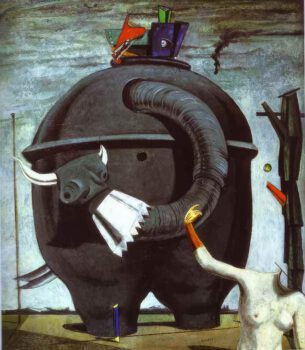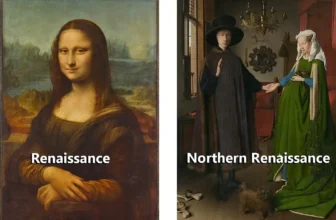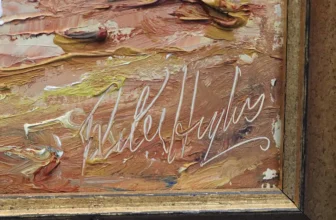Meaning of The Elephant Celebes by Max Ernst
In the vast landscape of 20th-century modern art, few paintings capture the eerie allure and haunting mystery of surrealism like The Elephant Celebes (1921) by Max Ernst. Often described as a dream turned mechanical nightmare, this painting stands as one of the most iconic works in Ernst’s career and one of the foundational masterpieces of the Surrealist movement. It is a striking blend of unconscious imagery, mechanical motifs, and anthropomorphic distortion, each element layered with symbolic depth and historical resonance.
But what is The Elephant Celebes really about? What meaning lies beneath its surreal surface? And why has it captivated scholars, critics, and artists for over a century?
Let’s delve into the layers of The Elephant Celebes, its origins, symbolism, meaning, artistic context, and legacy.
A Glimpse of the Painting
The Elephant Celebes presents a strange, dreamlike scene: in the center, a large, looming, metallic creature dominates the canvas. Its massive body resembles an industrial silo or a mechanical elephant, armless, legless, almost headless. A spout-like protrusion extends from its upper section, resembling an elephant’s trunk. This hulking, surreal machine-beast rests on sturdy legs like pillars, standing in a desolate, open space that feels both ancient and futuristic.
Surrounding the creature are disparate, almost disjointed objects. A headless female nude stands to the left, appearing doll-like and stiff. Her gesture is ambiguous, perhaps dancing, perhaps reaching, perhaps succumbing. Above her, a fish skeleton floats like a specter. The background is a pale, almost lunar landscape with a vaguely architectural ruin or colonnade in the distance. A severed mannequin arm juts out from the side of the “elephant.”
It’s a dreamscape, a fusion of the subconscious, mechanization, mythology, and memory. It doesn’t just invite interpretation, it demands it.
Who Was Max Ernst?
To understand The Elephant Celebes, one must understand Max Ernst (1891–1976). Born in Germany, Ernst was a central figure in the Dada and Surrealist movements. His work was deeply influenced by his experiences in World War I, which shattered traditional notions of reality, logic, and civilization. Ernst turned to art not merely to depict the world but to deconstruct it, rebuilding it through the lens of dreams, irrationality, and the unconscious mind.
He was heavily influenced by Sigmund Freud’s psychoanalytic theories, particularly the role of dreams and repressed memories. This fascination with the unconscious found a perfect outlet in Surrealism, the avant-garde movement that sought to release the creative potential of the subconscious mind.
Ernst’s artistic style was daring and experimental. He employed techniques like frottage (rubbing textures), grattage (scraping), collage, and automatic drawing to bypass conscious control and evoke the hidden recesses of the psyche.
The Origins of The Elephant Celebes
Painted in 1921 shortly after Ernst moved from Cologne to Paris, The Elephant Celebes represents a transitional moment. It bridges Dada’s irreverence and chaos with the more focused dream-logic of Surrealism. The painting’s title, Celebes, refers to the island now known as Sulawesi in Indonesia. However, Ernst reportedly took the name from a German schoolbook, where “Celebes” appeared beneath an image of a ceremonial corn-bin used by the people of the region. The object resembled an elephant in shape, an association that Ernst seized upon.
This cultural cross-reference, German colonial textbooks, non-Western ritual objects, mechanical forms, already hints at one of the key themes of the painting: the collision of civilization and primitivism, modernity and mythology.
Ernst painted it with oil on canvas, using a traditional medium to create something profoundly untraditional. The painting measures about 125 cm x 107 cm (49 x 42 inches), and today it is housed in the Tate Modern in London.
Symbolism and Meaning
The symbolism of The Elephant Celebes is complex, layered, and open to multiple interpretations. Yet several key themes emerge:
1. The Mechanical Beast: Dehumanization and War
The central figure, the “elephant”, looks less like an animal and more like a machine. It appears immobile, cold, and industrial, evoking a sense of lifeless oppression. This could symbolize the mechanization of human life, particularly in the wake of World War I, which turned men into cogs in a vast, destructive machine.
The absence of eyes, mouth, and organic limbs intensifies the feeling of dehumanization. This “elephant” is not wise or majestic; it is a looming, inanimate monolith, more like a factory or furnace than a creature. In the shadow of modern warfare, the machine becomes a metaphor for the loss of individuality and spirit.
2. The Nude Figure: The Female Body as Symbol
To the left of the elephant stands a nude female figure, headless, motionless, and ambiguous. She may symbolize vulnerability, eroticism, or objectification. Some scholars argue she represents the muse of the unconscious, the feminine principle in Surrealist theory that holds the key to the dream world.
Her lack of a head could signify the irrational or subconscious, bodies divorced from reason, or perhaps a comment on the suppression of women in both modern and ancient myths. Others have compared her to ancient fertility goddesses, contrasting with the masculine, industrial form of the elephant.
3. The Fish and the Floating Arm: Surrealist Juxtapositions
The fish skeleton in the sky defies gravity and logic, a clear nod to Surrealism’s love of unexpected juxtapositions. It could represent death, transformation, or the spiritual. The fish has historically been a symbol of rebirth, but here it’s skeletal, perhaps suggesting decay or the emptiness of myth in a mechanized age.
The mannequin-like severed arm may reference fragmented identity, dismembered consciousness, or simply a surreal play with form and function. Surrealists often used mannequins and body parts to express dissociation and dream logic.
4. The Landscape: Ancient vs. Futuristic
The pale, barren landscape feels both ancient and alien. The distant structure might be classical ruins or futuristic remnants, blurring time and place. Ernst creates a timeless, placeless stage where subconscious symbols can play freely.
This duality, past and future, human and machine, life and death, reinforces the central tension of the painting.
What Type of Art is The Elephant Celebes?
The Elephant Celebes is one of the earliest and most definitive works of Surrealism, though it still carries the residue of Dada.
Dada (1916–1924) was anti-art: irrational, chaotic, and a reaction to the horrors of World War I. It rejected reason and aesthetic norms.
Surrealism (beginning in the mid-1920s) was more constructive, seeking to access deeper truths via dreams, automatic writing, and irrational associations.
Ernst stood at the junction of both movements. The Elephant Celebes contains Dadaist collage logic, disparate elements jammed together, but also surreal coherence. It functions like a dream: strange yet strangely ordered.
Technically, it’s an oil painting, but conceptually it’s an example of automatism, symbolism, and proto-installation art. Ernst doesn’t just depict a scene; he constructs a symbolic system.
What Is Happening in the Painting?
This is the question viewers most often ask, and the one with no definitive answer.
Interpretations vary widely:
A Ritual Scene: Some interpret it as a ceremonial or mythological event, perhaps a sacrifice, a procession, or a dream ritual. The elephant-machine could be a totem or god-figure. The nude may be an offering, priestess, or victim.
A Surreal Allegory: Others see it as an allegory of modernity: the nude represents lost humanity or nature; the elephant, the encroachment of industrialization.
A Dream Made Visible: From a Freudian lens, the image might be a visualization of subconscious desires and fears, sexuality, death, power, and loss.
A Political Critique: Given its postwar context, the painting might also critique nationalism, imperialism, or technological violence. The hybrid elephant-machine was possibly inspired by colonial imagery in textbooks, hinting at Europe’s exploitation of other cultures.
There is no single answer, and Ernst himself offered little clarification, typical of Surrealists who believed in preserving ambiguity.
The Legacy and Impact of The Elephant Celebes
The Elephant Celebes is one of the most studied and revered works in modern art. It marks a pivotal moment in Ernst’s career and the transition from Dada’s destruction to Surrealism’s reconstruction.
It influenced generations of artists, from Salvador Dalí to Rene Magritte, and its themes resonate in contemporary art, film, and literature. Its visual language, mechanical creatures, fragmented bodies, and desolate dreamscapes, has echoes in science fiction, cyberpunk, and postmodern visual media.
The painting’s unsettling mixture of eroticism, alienation, and mechanization has even been seen as a precursor to later 20th-century themes, including existentialism and posthumanism.
Where is The Elephant Celebes Today?
Today, The Elephant Celebes is part of the permanent collection of the Tate Modern in London, one of the world’s most prestigious modern art museums. It remains on display, drawing thousands of visitors and continuing to inspire awe, confusion, and critical thought.
The painting is considered a highlight of the Tate’s Surrealist collection, and it is frequently featured in exhibitions, textbooks, and documentaries exploring the evolution of modern art.
The Dream That Walks Like a Machine
The Elephant Celebes by Max Ernst is not a painting you simply “understand.” It is a riddle, a poem, a dream, a canvas alive with contradictions. At once ancient and futuristic, sexual and mechanical, spiritual and industrial, it holds a mirror to the human psyche fractured by war, modernity, and subconscious desire.
Rather than answering our questions, it deepens them. What happens when human bodies are turned into objects? When machines become gods? When dreams become more truthful than waking life?
In The Elephant Celebes, Ernst doesn’t offer solutions, he opens a door to the unconscious, inviting us to step through, uncertain and curious. It is a masterpiece not because it resolves meaning, but because it eternally generates it.
In a world increasingly defined by technology, alienation, and fragmented identity, The Elephant Celebes continues to speak, not with words, but with symbols, silence, and surreal truth.




